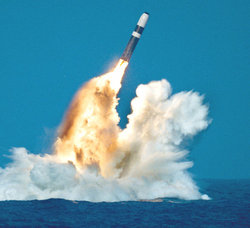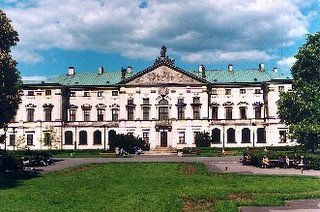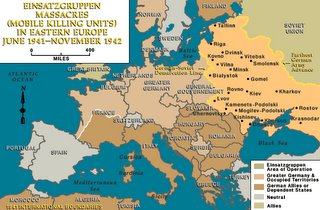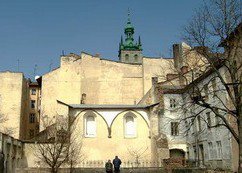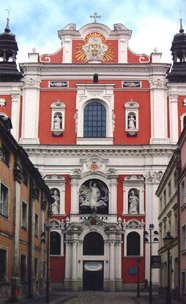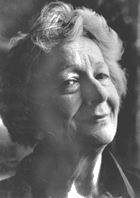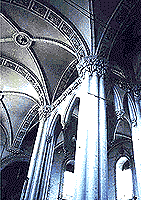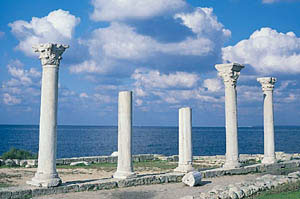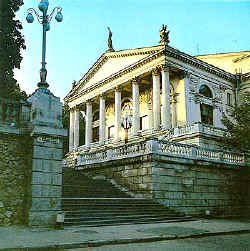Though I had planned to attend last year's Zbigniew Herbert Days in Lviv, Ukraine, last March, history intervened and I was unable to be in Lviv until April. I did, however, find this Report on the Symposium held in Herbert's "native" city [Lwow, in Poland], as published by the Polish Cultural Bulletin 12 (156):
Zbigniew Herbert Days were held in Lviv on 16-17 March [2005]. The presentation of Zbigniew Herbert's first book ever published in Ukraine took place at Ivan Franko [Lviv] University. The nearly 600-page bilingual [Polish - Ukrainian] selection of verse, translated by Viktor Dmytruk, was published by the distinguished Literatskye Kamenar Lviv Publishing House. The volume kicks off a Library of Slavonic Literatures, whose second work is to be 'High Castle' by Lviv-born Stanisław Lem. Kamenar’s further plans include translations of Mickiewicz and Słowacki. The book’s début was preceded by a seminar opened by Ivan Vakarchuk, rector of Lviv University, and conducted by Professor Janusz Odrowąż-Pieniążek, president of the Polish Writers’ Association and director of the Warsaw Literary Museum. Zbigniew Herbert and his literary creations were also talked about by the late poet’s friends, including Zdzisław Najder and Jacek Łukasiewicz, as well as Ukrainian admirers of his work. Two memorial plaques were unveiled: at St Anthony’s Church in the Lychakiv district of Lviv and in the house at 22 Lychakovska Street [isn't it at about 68 Lychakovska (formerly Lenin) Street instead?] where the writer was born and spent his childhood [1924-1933].
The plaque was blessed by the Latin Metropolitan Archbishop of Lviv, Cardinal Marian Jaworski who celebrated holy mass and delivered a homily dedicated to Herbert. The plaque was unveiled by the poet’s sister, Halina Herbert-Żebrowska. 'Epilogue of the Storm', an exhibition devoted to Herbert prepared by Warsaw’s Literary Museum, opened at the House of Art in Copernicus Street. Herbert Days were organised by the Consulate General of the Republic of Poland in Lviv and the Foundation to Aid Poles in the East in co-operation with the Federation of Polish Organisations in Ukraine and the monthly literary magazine 'Lviv Encounters' which marked the occasion by publishing a special issue devoted entirely to Herbert."
www.msz.gov.pl/files/file_library/42/20020325a_7005.doc
*
Last April, I had stumbled upon the plaque at the childhood home of Herbert on Lychakovska Street, and last Tuesday, N. and I attended an Epiphany Mass interspersed with folk carols (sung in Polish and Ukrainian, and underscored by synthesizer, electric guitar, and hand drums) at Saint Anthony's Polish Church, where I found the second new Herbert memorial plague next to the marble basin in which "Herbert was christianed into this world". I am still trying to recall and locate the poem fragment included on this second plaque. [N. told me that Saint Anthony's Polish Church, with its largely bilingual, trilingual, or quattrolingual young membership, is also a center for Contemporary Chamber Opera in Lviv.]
**
Report from the Besieged City Too old to carry arms and fight like the others -
they graciously gave me the inferior role of chronicler
I record - I don't know for whom - the history of the siege
I am supposed to be exact but I don't know when the invasion began
two hundred years ago in December in September perhaps yesterday at dawn
everyone here suffers from a loss of the sense of time
all we have left is the place the attachment to the place
we still rule over the ruins of temples spectres of gardens and houses
if we lose the ruins nothing will be left
I write as I can in the rhythm of interminable weeks
monday: empty storehouses a rat became the unit of currency
tuesday: the mayor murdered by unknown assailants
wednesday: negotiations for a cease-fire the enemy has imprisoned our messengers
we don't know where they are held that is the place of torture
thursday: after a stormy meeting a majority of voices rejected
the motion of the spice merchants for unconditional surrender
friday: the beginning of the plague saturday: our invincible defender
N.N. committed suicide sunday: no more water we drove back
an attack at the eastern gate called the Gate of the Alliance
all of this is monotonous I know it can't move anyone
I avoid any commentary I keep a tight hold on my emotions I write about the facts
only they it seems are appreciated in foreign markets
yet with a certain pride I would like to inform the world
that thanks to the war we have raised a new species of children
our children don’t like fairy tales they play at killing
awake and asleep they dream of soup of bread and bones
just like dogs and cats
in the evening I like to wander near the outposts of the city
along the frontier of our uncertain freedom.
I look at the swarms of soldiers below their lights
I listen to the noise of drums barbarian shrieks
truly it is inconceivable the City is still defending itself
the siege has lasted a long time the enemies must take turns
nothing unites them except the desire for our extermination
Goths the Tartars Swedes troops of the Emperor regiments of the Transfiguration
who can count them
the colours of their banners change like the forest on the horizon
from delicate bird's yellow in spring through green through red to winter's black
and so in the evening released from facts I can think
about distant ancient matters for example our
friends beyond the sea I know they sincerely sympathize
they send us flour lard sacks of comfort and good advice
they don’t even know their fathers betrayed us
our former allies at the time of the second Apocalypse
their sons are blameless they deserve our gratitude therefore we are grateful
they have not experienced a siege as long as eternity
those struck by misfortune are always alone
the defenders of the Dalai Lama the Kurds the Afghan mountaineers
now as I write these words the advocates of conciliation
have won the upper hand over the party of inflexibles
a normal hesitation of moods fate still hangs in the balance
cemeteries grow larger the number of defenders is smaller
yet the defence continues it will continue to the end
and if the City falls but a single man escapes
he will carry the City within himself on the roads of exile
he will be the City
we look in the face of hunger the face of fire face of death
worst of all - the face of betrayal
and only our dreams have not been humiliated
Zbigniew Herbert (1924 - 1998)
(translated from the Polish by John and Bogdana Carpenter. Ecco Press 1982)
(c) Zbigniew Herbert and John and Bogdana Carpenter 1982

